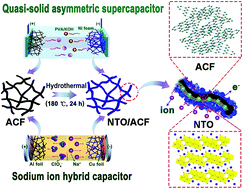In situ synthesis of a highly active Na2Ti3O7 nanosheet on an activated carbon fiber as an anode for high-energy density supercapacitors†
Abstract
This study proposes a unique hybrid structure with a one-dimensional activated carbon fiber (a uniform diameter of 300 nm) as a support for two-dimensional Na2Ti3O7 nanosheets (thickness of 20 nm) for a high-performance supercapacitor electrode (Na2Ti3O7/activated carbon fiber). With the important role of nanocomposites in improving electron and ion transportation, the Na2Ti3O7/activated carbon fiber displays a high specific capacity of 152 F g−1 at 1 A g−1, and a specific energy of 47.5 W h kg−1 at a specific power of 900 W kg−1 in the quasi-solid state supercapacitor with a voltage window of 0–1.6 V. Significantly, the sodium ion hybrid capacitor based on the Na2Ti3O7/activated carbon fiber nanocomposite as an anode and an active carbon fiber as a cathode exhibits a maximum specific capacitance of up to 76.8 F g−1 at 1 A g−1 and a high energy density of 127.73 W h kg−1 at 95.79 W kg−1 within a wide operating voltage of 3.0 V. The excellent electrochemical performance of the Na2Ti3O7/activated carbon fiber nanocomposite benefits from the facile diffusion of electrons and ions, and a high structural stability during the electrochemical process.



 Please wait while we load your content...
Please wait while we load your content...